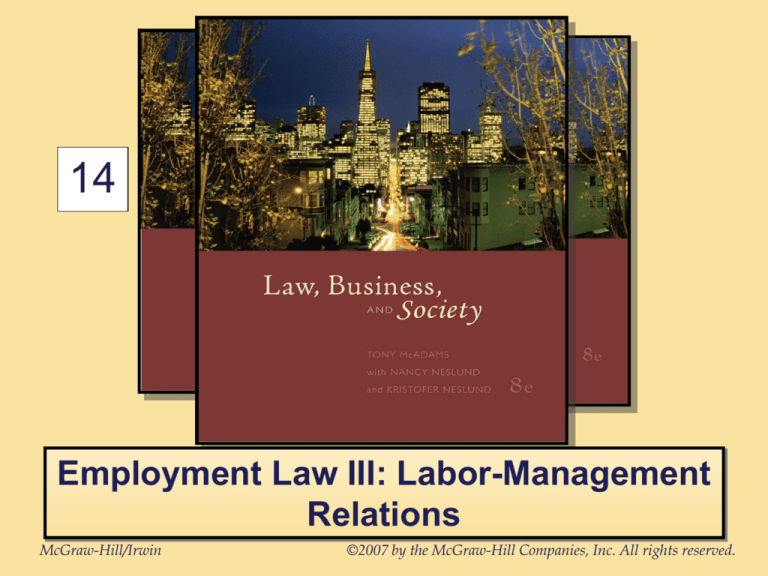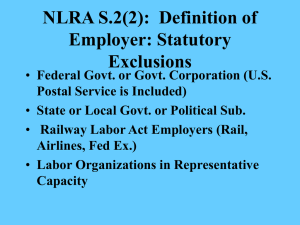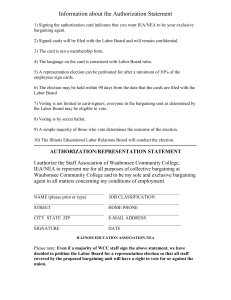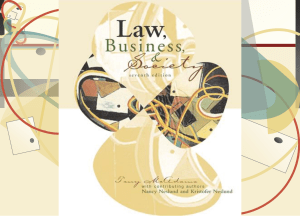
14
Employment Law III: Labor-Management
Relations
McGraw-Hill/Irwin
©2007 by the McGraw-Hill Companies, Inc. All rights reserved.
Chapter
14
Employment Law III:
Labor-Management Relations
Key Points
• Understand the history out of which labor
unions grew
• Identify unfair labor practices by
management and unions
• Understand the union election process
• Understand the collective bargaining
process and the consequences of work
stoppages
Unions Today
Although the labor union movement grew up as a
counter weight to big business, today it appears to be
more of a counterweight to big government:
• 40% of public sector employees belong to unions
• Only 7.9% of private sector employees belong to
unions
On the other hand:
• Corporate scandals have shaken worker faith in
corporate America
• Some new groups are looking at unions, such as
physicians and teaching assistants
Labor Union History—Part I
• Late 1800s: The industrial revolution prospered
through the exploitation of labor—adult and child
• 1870s-’80s: The Knights of Labor admitted
nearly all workers and started fighting for wage and
hour laws, health care and mandatory education
• AFL later organized workers along craft lines
• 1932: Norris-LaGuardia Act passed providing
some minimal protection for unionizers
• 1935: CIO evolved to serve the interests of
ordinary labor
Labor Union History—Part II
• 1935: Wagner Act passed clearly legalizing unions
and establishing the NLRB
• 1947: Taft-Hartley Act passed prohibiting unfair labor
practices by unions
• 1955: AFL and CIO combined
• 1959: Landrum-Griffin Act passed regulating union
financial matters and providing a “Bill of Rights” for union
members
• Today: The National Labor Relations Act (NLRA) now
includes the Wagner and Taft-Hartley Acts and much of
the Landrum-Griffin Act
Unfair Labor Practices by Management
Section 8(a) of the NLRA makes it an unfair labor practice for an
employer to:
• Interfere with, restrain, or coerce employees in the exercise
of their legal rights
• Dominate, interfere, or assist with the formation of any labor
organization, including contributing financial support to it
• Encourage or discourage membership in any labor
organization by discrimination in regard to hiring, tenure,
promotion, salary or any other term of employment
• Discharge or take any other action against an employee for
filing charges or giving testimony under the act
• Refuse to bargain collectively with a duly certified
representative of employees
Unfair Labor Practices by Unions
Section 8(b) makes it an unfair labor practice for a labor organization to:
• Restrain or coerce any employee in the exercise of his or her legal rights
• Cause or attempt to cause an employer to discriminate against an
employee who has chosen not to join a labor organization or has been
denied membership
• Refuse to bargain collectively with an employer on behalf of the
bargaining unit it is certified to represent
• Induce or attempt to induce an employer to engage in secondary boycott
activities
• Require employees to become union members and then charge them
excessive or discriminatory dues
• Try to make an employer compensate workers for services not performed
• Picket or threaten to picket an employer to force the employer to
recognize or bargain with a labor organization that is not duly certified
National Labor Relations Board
(NLRB)
The primary obligations of the NLRB are:
• To designate appropriate bargaining units of workers
(deciding which workers have sufficient community
of interest so their needs can best be met and so
collective bargaining is efficient for employer and
union)
• To conduct elections for union representation
• To certify results of such elections
• To investigate, prosecute and adjudicate charges of
unfair labor practices
Elections
Election Petition: A union, employee or employer may
initiate formal organizing process by filing an election
petition with the NLRB
• Minimum requirement is signatures of 30% of
employees
• In practice, usually no election without signatures of
50-65%
Determination of appropriate bargaining unit:
• Requires a community of interest among employees
• Certain employees must be excluded, such as
supervisors
Election is by majority of votes cast by employees of the
bargaining unit identified
Protection of Free Speech
During Election Process
Employers:
• Cannot use direct or indirect threats of reprisal or
force to influence outcome
• Also cannot use promise of future benefits
• Example: Multi-Ad Services v. NLRB (7th Cir.
2001)
Unions:
• Restricted in types of acceptable persuasion,
although promises of benefits not as problematic
here
• Example: Wal-Mart Stores v. NCRB (8th Cir.
2005)
Loss of Bargaining Unit
Decertification: After at least one year, an unsatisfied
group of employees may file decertification petition
with NLRB, which must have the support of at least
30% of covered employees; election would then be
held
Withdrawal of Recognition: Employer may unilaterally
withdraw recognition of union only where union has
lost support of majority of its members; one way to
demonstrate that is to file an RM petition with the
NLRB for employer-requested election
Collective Bargaining Principles
Union as Exclusive Bargaining Agent: The union is
the exclusive agent for all employees within that
bargaining unit, whether they voted for union or not;
employer must deal with certified representative
Good Faith Bargaining: Section 8(a)(5) of the NLRA
requires employer to engage in good faith collective
bargaining with a union representative and Section
8(b)(3) imposes same duty on unions
Bargaining in Good Faith
Relevant factors:
• An open mind an sincere desire to reach agreement
• Counterproposals must be offered when a proposal is rejected
• Positions may not be constantly changed
• Employee must be willing to incorporate oral agreements into a
written contract
Mandatory bargaining subjects: Wages, hours and “other terms and
conditions of employment”
Permissive and prohibited bargaining subjects:
• Either party may raise permissive subjects, but may not pursue
them to a bargaining impasse
• Prohibited bargaining subjects are those that are illegal under
the NLRA or other laws
Example: Colgate-Palmolive Co. (NLRB 1997)
Work Stoppages
Strikes:
• Unfair labor practice strikes: those instituted by workers in
response to employer’s unfair labor practice
• Economic strikes: those instituted purely as economic
weapons
• Example: Diamond Walnut Growers v. NRB (D.C. Cir. 1997)
Lockout: Management locks its doors to some or all of its employees
Picketing and Boycotting:
• Primary picketing/boycotting is expressed directly against
employer
• Secondary picketing/boycotting against third parties, such as
suppliers, is generally illegal
Employees’ Rights within or
against the Union
• Unions have duty to fairly represent all members of
bargaining unit, whether or not they become union members
• Bill of Rights is designed to ensure equal voting rights, right
to sue the union, and rights of free speech and assembly
• Nonunion employees can be compelled to pay union dues
and fees only for core collective bargaining activities
• 22 states have enacted right-to-work laws; in these states,
nonmembers do not pay dues or fees but, as members of
bargaining unit, they must be represented by the union









